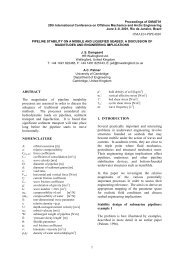Cantilever-like micromechanical sensors - Artek
Cantilever-like micromechanical sensors - Artek
Cantilever-like micromechanical sensors - Artek
You also want an ePaper? Increase the reach of your titles
YUMPU automatically turns print PDFs into web optimized ePapers that Google loves.
Rep. Prog. Phys. 74 (2011) 036101 A Boisen et al<br />
2.2.1. Origin of surface stress—experimental focus.<br />
Although the equation for measuring the surface stress from<br />
a cantilever deflection has been available for more than 100<br />
years, the origin of the surface stress and the relation to the<br />
force transduction (chemical recognition event to mechanical<br />
deflection of the cantilever) has been under dispute and is still<br />
not clarified within the research community. There exist a few<br />
theoretical papers that try to decipher the fundamental physics<br />
of the origin of surface stress [67–69]. These papers are not<br />
linked to experimental studies. In this section, we will focus<br />
on the most relevant experimental findings existing within the<br />
community. For clarity, we only consider studies of DNA<br />
hybridization and alkanethiol layers.<br />
DNA hybridization is studied in two steps. First, singlestranded<br />
DNA (ss-DNA) is immobilized on a cantilever. The<br />
actual hybridization event takes place when a complementary<br />
ss-DNA strand is introduced, resulting in a hybridized doublestranded<br />
DNA (ds-DNA) bound to the cantilever. The first<br />
proposal on the physics of surface stress came in 2000<br />
from Fritz et al, where it was suggested that the surface<br />
stress originates from electrostatic, steric and hydrophobic<br />
interactions [19] between the hybridized DNA strands on<br />
the cantilever. It was observed that the DNA hybridization<br />
event causes a compressive surface stress. DNA strands hold<br />
a net negative charge. It is argued that the electrostatic<br />
interaction changes since ds-DNA has a larger number of<br />
charges compared with ss-DNA. The steric contribution is<br />
believed to arise from a denser chain packing as a result<br />
of the hybridization. A year later, Wu et al [70] showed<br />
on-line measurements of a cantilever first being functionalized<br />
with ss-DNA and then exposed to complementary DNA for<br />
hybridization. The immobilization step resulted in a large<br />
compressive stress whereas the hybridization event resulted<br />
in a small tensile stress. Their findings indicated that the<br />
cantilever deflects in the opposite direction as to what Fritz<br />
et al reported. Furthermore, the cantilever was observed to<br />
bend in opposing directions for the ss-DNA immobilization<br />
and the subsequent ds-DNA hybridization. Intuitively this is<br />
rather surprising as one might simply expect the cantilever<br />
to bend more (in the same direction) as more molecules are<br />
added to the surface. To explain the experimental results,<br />
Wu et al argued that the surface stress cannot be a result<br />
of electrostatic and steric interactions alone. They proposed<br />
to also consider configurational entropy, which is related to<br />
the order of the immobilized molecules. The ss-DNA has<br />
a significantly lower persistence length than ds-DNA (under<br />
the same buffer conditions), which means that the ds-DNA<br />
has a higher stiffness and is more rod <strong>like</strong>. As a result, the<br />
cantilever is required to bend more to ensure sufficient space<br />
for the ss-DNA strands to form a SAM. The ds-DNA in turn will<br />
not force the cantilever to deflect as much since it requires less<br />
space to form a SAM due to its more rigid structure. Therefore,<br />
when Wu et al started with a blank cantilever and introduced<br />
ss-DNA for immobilization they observed a compressive stress<br />
on the cantilever. When the complementary strands were<br />
introduced to form the ds-DNA this stress was released (since<br />
a more ordered SAM could be formed). They then observed a<br />
tensile stress/release of compressive stress.<br />
7<br />
However, this does not explain why their findings<br />
contradict the findings of Fritz et al with respect to<br />
DNA hybridization. To further support their theory on<br />
the significance of the configurational entropy, Wu et al<br />
immobilized ss-DNA on two different cantilevers in a 1M<br />
buffer. These cantilevers were then exposed to two different<br />
hybridization conditions. In the first situation, DNA was<br />
hybridized under the same buffer conditions (1M) and a tensile<br />
stress was observed. In the second situation, the buffer<br />
concentration was reduced to 0.1M before the complementary<br />
ss-DNA strand was introduced. The change in buffer<br />
concentration forced the ss-DNA to form a more ordered<br />
monolayer. In turn, a compressive stress was observed during<br />
hybridization. This clearly indicates that configurational<br />
entropy plays a role in signal generation and it stresses<br />
the importance of controlling all aspects of a cantilever<br />
measurement (buffer conditions, pre-treatments, temperature<br />
variations, etc) since several effects are involved in generating<br />
the surface stress signal.<br />
The group of Rachel McKendry has studied the origin<br />
of surface stress in a methodical manner. In 2002 [71]<br />
the influence of the physical steric crowding of molecules<br />
on a cantilever was pinpointed as the main contributor to<br />
the cantilever deflection for DNA hybridization. It was<br />
seen that the hybridization signal is close to non-existent<br />
when the density of probe ss-DNA is tailored for maximized<br />
hybridization efficiency. Again, this indicates that molecules<br />
with ‘sufficient space’ do not generate a cantilever deflection.<br />
In 2007, the effects of electrostatics [72] were investigated.<br />
Here, simple SAMs of thiolated n-alkane chains with<br />
different end-groups were used as model system. The<br />
active SAM had carboxyl-groups at the end, which could<br />
be protonated/deprotonated upon pH variations. The main<br />
physical effect of the cantilever deflection in this situation was<br />
assigned to electrostatic repulsion and ionic hydrogen bond<br />
formation. Emphasis was also put on the counter ions present<br />
in the aqueous solution; these can affect both the magnitude<br />
and direction of the cantilever deflection. Figure 6 shows<br />
the contribution from each individual effect (electrostatic<br />
repulsion and ionic hydrogen bond formation) as well as the<br />
effective interactions. Experimental data are also plotted and<br />
seen to agree well with the proposed theory.<br />
In 2008, McKendry, Sushko and co-authors proposed<br />
the ‘first quantitative model to rationalize the physics of<br />
nanomechanical <strong>sensors</strong>’ [73]. Here, a theoretical model is<br />
developed that predicts the cantilever deflection direction and<br />
magnitude upon pH variations of the buffer solution and for<br />
various chain lengths of SAMs. The model considers the<br />
effects of chemical, elastic and entropic properties of both<br />
cantilever material and sensing layer.<br />
Recently, the group of Grütter [74] analysed the effects of<br />
intermolecular electrostatics, Lennard-Jones interactions and<br />
adsorption-induced changes in the electronic density of a metal<br />
film when thiolated alkane chains are immobilized on a goldcoated<br />
silicon cantilever. Their findings indicate that it is the<br />
latter effect combined with the associated electronic charge<br />
transfer from the gold to the thiol bond that account for the<br />
largest contribution to the measured surface stress. These





